Vehicle Stability Control System (W/O Vdim) -- System Description |
| FUNCTION DESCRIPTION |
- HINT:
- The skid control ECU is located within the brake actuator assembly.
- The yaw rate sensor and acceleration sensor are combined in a single unit. This unit communicates with the skid control ECU through CAN communication.
ABS (Anti-lock Brake System)
The ABS helps prevent the wheels from locking when the brakes are applied firmly or when braking on a slippery surface.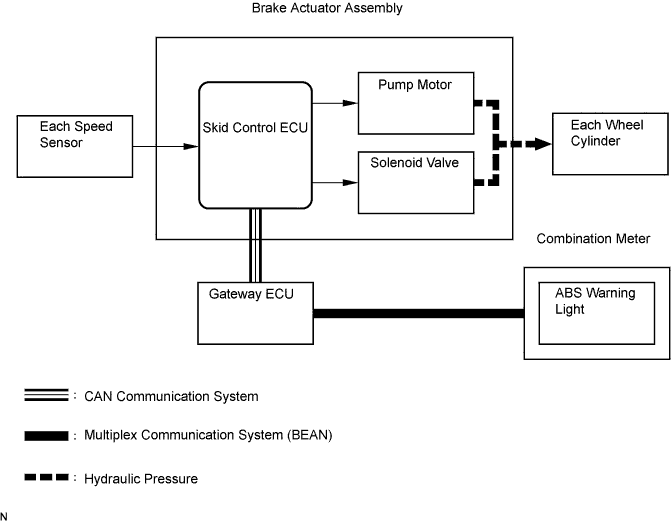
Operation description
The skid control ECU detects wheel lock condition by receiving vehicle speed signals from each speed sensor, and sends control signals to the pump motor and solenoid valve. The pump motor and solenoid valve avoid wheel lock by controlling the brake fluid pressure of each wheel cylinder.
The ABS warning light comes on when the ABS system is malfunctioning.
EBD (Electronic Brake force Distribution)
The EBD control utilizes ABS, and performs proper brake force distribution between the front and rear wheels in accordance with driving conditions.
When braking while cornering, it also controls the brake forces of the right and left wheels, helping to maintain vehicle behavior.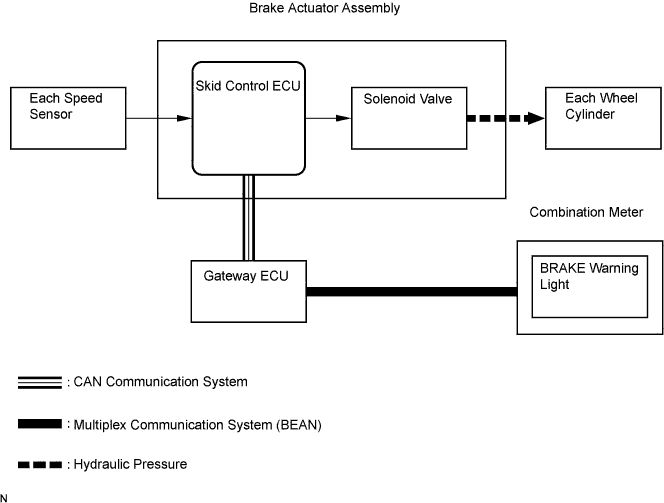
Operation description
The skid control ECU receives the speed signals from each speed sensor to detect the slip condition of the wheels and sends the control signals to the solenoid.
The solenoid valve controls the fluid pressure of each wheel cylinder and splits the control power properly between the front and rear wheels and the right and left wheels.
The BRAKE warning light comes on to indicate a malfunction in the EBD system.
BA (Brake Assist)
The primary purpose of the brake assist system is to provide auxiliary brake force to assist the driver who cannot generate a large enough brake force during emergency braking, thus helping to maximize the vehicle's brake performance.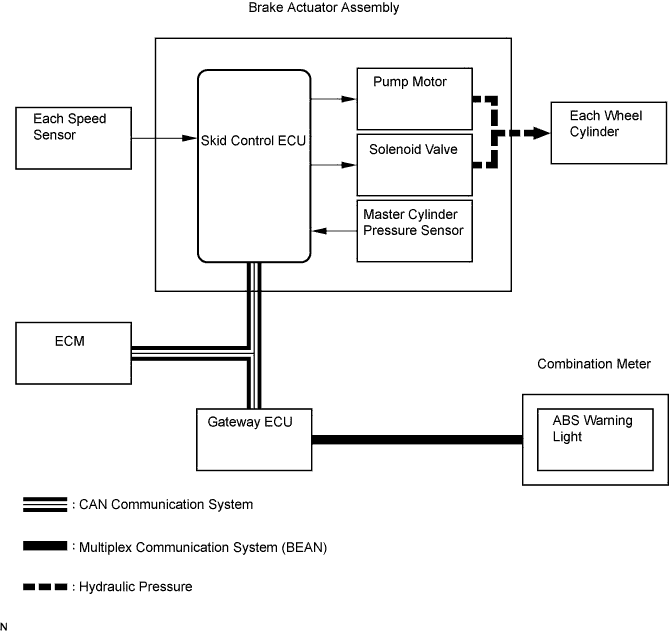
Operation description
The skid control ECU receives the speed signal from each speed sensor and the fluid pressure signal from the master cylinder pressure sensor to determine whether brake assist is necessary. If brake assist is necessary, the skid control ECU sends control signals to the pump motor and solenoid. The pump and the solenoid valve then control the pressure applied to each wheel cylinder.
The ABS warning light comes on to indicate a malfunction in the BA system.
TRC (Traction Control)
The TRC system helps prevent the drive wheels from slipping when the driver presses down on the accelerator pedal excessively when starting off or accelerating on a slippery surface.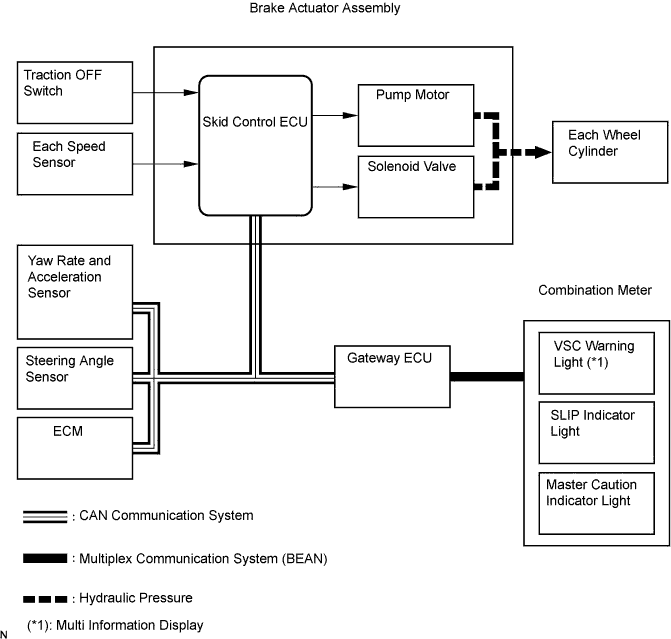
Operation description
The skid control ECU detects the vehicle's slip condition by receiving signals from each speed sensor and ECM via CAN communication. The skid control ECU controls engine torque with the ECM via CAN communication and oil pressure through the pump and solenoid valve.
The SLIP indicator light blinks when the system is operating. If a malfunction occurs in the TRC system, both master caution and SLIP indicator lights will come on and the DTC will be displayed on the multi information display.
Traction OFF switch stops traction control operation.
VSC (Vehicle Stability Control)
The VSC system helps prevent the vehicle from slipping sideways as a result of strong front or rear wheel skid during cornering.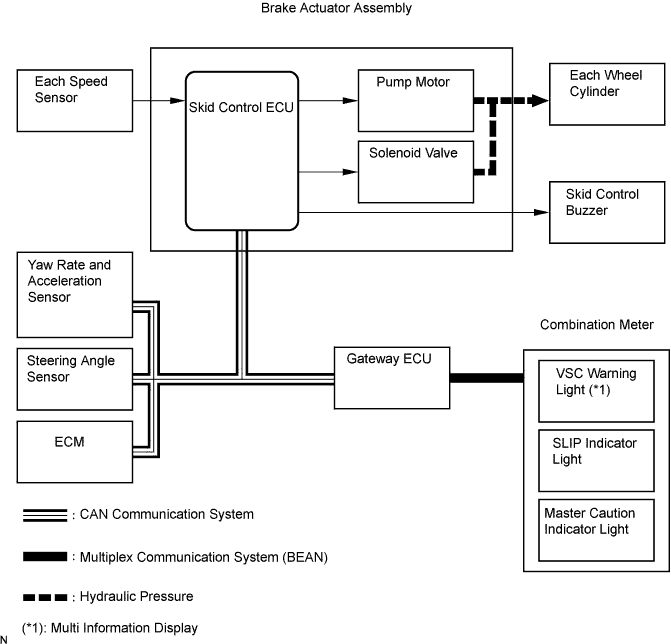
Operation description
The skid control ECU determines the vehicle condition by receiving signals from the speed sensor, yaw rate and acceleration sensor and steering angle sensor. The skid control ECU controls engine torque with the ECM via CAN communication and fluid pressure with the pump and solenoid valve.
The SLIP indicator light blinks and the skid control buzzer sounds when the system is operating. When there is a malfunction in the VSC system, both master caution and SLIP indicator lights will come on and the DTC will appear on the multi information display.
| HILL-START ASSIST CONTROL (A/T) |
The hill start assist control detects rearward motion of the vehicle. It automatically increases the brake hydraulic pressure for the four wheels in order to reduce the rearward speed of the vehicle.
The vehicle tends to slide backward when the driver moves his foot from the brake pedal to the accelerator pedal trying to start on a steep or slippery uphill. This function is effective in this kind of situation in which starting is difficult.
After a maximum of 5 seconds, fluid pressure is gradually released and control will be completed.
| DYNAMIC RADAR CRUISE CONTROL (A/T) |
When a greater deceleration than usual is required while driving in vehicle control mode, braking force is generated by the brake hydraulic pressure control in accordance with the signal from the distance control ECU.
| PRE-CRASH CONTROL (A/T) |
The pre-crash system predicts frontal collisions with other vehicles or obstructions. By winding up the seat belts prior to collision, and performing brake control and brake assist control, it lessens the impact during the collision.
The extremely high frequency radar recognizes if there is a vehicle or obstruction on the road ahead, and the distance control ECU makes a judgement on whether a collision is unavoidable from the position of the object, the speed and the road surface.
The distance control ECU sends this information via a CAN communication to the seat belt control ECU, suspension control ECU and skid control ECU, to operate each control element of the pre-crash system.
| ABS with EBD, BA, TRC and VSC OPERATION |
The skid control ECU calculates vehicle stability tendency based on the signals from the speed sensor, yaw rate and acceleration sensor and steering angle sensor. In addition, it evaluates the results of the calculations to determine whether any control actions (control of the engine output torque by electronic throttle control and of the wheel brake pressure by the brake actuator assembly) should be implemented.
The SLIP indicator blinks and the skid control buzzer sounds to inform the driver that the VSC system is operating. The SLIP indicator also blinks when traction control is operating, and the operation being performed is displayed.
| FAIL SAFE |
When a failure occurs in the ABS with BA, TRC and VSC systems, the ABS and VSC warning lights, and SLIP indicator light come on and ABS with BA, TRC and VSC operations are prohibited. In addition to this, when there is a failure that disables the EBD operation, the BRAKE warning light also comes on and the EBD operation is prohibited.
If control is prohibited due to a malfunction during operation, control will be disabled gradually.
This is to avoid sudden vehicle instability.
| INITIAL CHECK |
When the vehicle speed first becomes approximately 4 mph (6 km/h) or more after the engine switch is turned on (IG), each solenoid valve and motor of the brake actuator is sequentially activated to perform an electrical check. During the initial check, the operating sound of solenoid valve and motor can be heard from the engine compartment, but this is not a malfunction.
| SERVICE MODE |
VSC operation can be disabled by operating the intelligent tester.
- HINT:
- Refer to the intelligent tester operator's manual for further details.
| FUNCTION OF COMPONENTS |
| Components | Function |
| Speed sensor (Semiconductor type) | Detects the wheel speed and sends the signal to the skid control ECU. |
| Skid control ECU (housed in brake actuator assembly) |
|
| Brake actuator assembly |
|
| Solenoid relay |
|
| Motor relay (ABS MOTOR2 relay) | Supplies power to the pump motor. |
| Fail safe relay (ABS MOTOR1 relay) | Cuts off power to the motor when the pump motor circuit malfunctions. |
| Steering angle sensor |
|
| Yaw rate and acceleration sensor |
|
| Master cylinder pressure sensor |
|
| Stop light switch | Detects the brake operating conditions and inputs the results to the skid control ECU. |
| Brake pedal load sensing switch |
|
| ECM | Controls the engine output when TRC and VSC are operating with the skid control ECU via CAN communication. |
| Skid control buzzer | Intermittently sounds to inform the driver that the VSC is operating. |
| ABS warning light |
|
| BRAKE warning light |
|
| SLIP indicator light |
|
| VSC warning light (Multi information display) |
|
| Master caution indicator light | Comes on to inform the driver that a malfunction has occurred. |